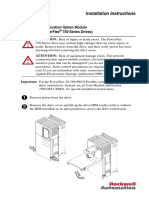0% found this document useful (0 votes)
47 views2 pages1.a Numpy Code
The document introduces NumPy, a Python library that provides efficient operations for manipulating large multi-dimensional arrays and matrices. It shows how NumPy can be used to create arrays from scratch or from existing Python lists, and demonstrates various array properties and operations like shape, size, indexing, slicing, and reshaping arrays into different dimensions.
Uploaded by
venkatesh mCopyright
© © All Rights Reserved
We take content rights seriously. If you suspect this is your content, claim it here.
Available Formats
Download as PDF, TXT or read online on Scribd
0% found this document useful (0 votes)
47 views2 pages1.a Numpy Code
The document introduces NumPy, a Python library that provides efficient operations for manipulating large multi-dimensional arrays and matrices. It shows how NumPy can be used to create arrays from scratch or from existing Python lists, and demonstrates various array properties and operations like shape, size, indexing, slicing, and reshaping arrays into different dimensions.
Uploaded by
venkatesh mCopyright
© © All Rights Reserved
We take content rights seriously. If you suspect this is your content, claim it here.
Available Formats
Download as PDF, TXT or read online on Scribd
/ 2





































